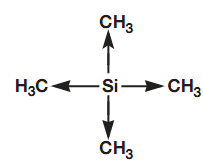Tetramethylsilane:
Let us look at what occurs if we calculate the chemical shift in frequency units of hertz. The scale displayed in figure is for a 60 MHz nmr spectrometer. The 60 MHz considers to the frequency of the energy needed to cause resonance. So, the signal at 3 ppm has a Larmor frequency that is 180 Hz faster than the signal because of TMS (180 Hz is 3 ppm of 60 MHz).
Though, we could as well measure this spectrum by using a more powerful nmr spectrometer that results in the protons comprising precessional frequencies in the order of 100 MHz.

Figure: Tetramethylsilane (TMS).
In this condition, the signal at 3 ppm is because of a proton that is precessing 300 Hz faster than the protons for TMS. If we compute the chemical shift of this peak in ppm, this would still be 3 ppm, because 300 Hz is 3 ppm of 100 MHz. though, if we employed a scale measured in Hertz, we would have to describe the power of the nmr spectrometer used. With chemical shift calculated in parts per million, the chemical shift will be similar no matter what type of instrument is used.